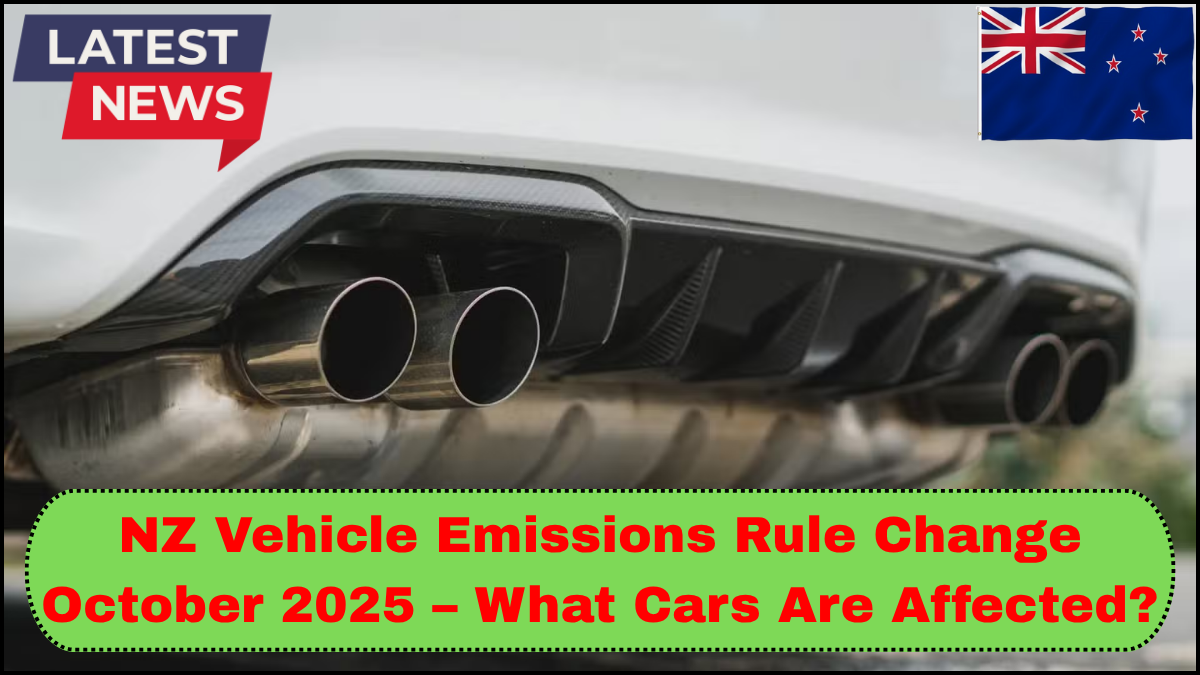New Zealand is set to tighten its grip on vehicle emissions in October 2025, with major regulatory changes aimed at cutting pollution and aligning the country with international environmental standards. The NZ Vehicle Emissions Rule October 2025 will directly impact what kinds of vehicles can be imported and sold, particularly targeting used cars and older internal combustion engine models.
This move is part of the broader Clean Car Programme, which encourages the adoption of low and zero-emission vehicles while phasing out high-emission options. Whether you’re an importer, dealer, or buyer, understanding the specifics of this rule is crucial to avoiding penalties and making informed choices.

What Is the NZ Vehicle Emissions Rule October 2025?
The NZ Vehicle Emissions Rule October 2025 introduces new requirements for light vehicles (including cars, SUVs, and utes) entering the New Zealand market. From this date forward, all newly imported vehicles—whether new or used—must meet the stricter Euro 6d emissions standard (or equivalent under other standards like Japan’s JC08/WTLC).
This change brings New Zealand in line with countries like the UK, EU members, and Australia, which have already implemented or are moving toward Euro 6 compliance. The focus is on reducing nitrogen oxide (NOx), carbon monoxide (CO), and particulate matter, which are major contributors to air pollution.
How Will This Affect Imported Cars?
The most immediate impact will be on used vehicle imports, which make up the majority of car sales in New Zealand. Vehicles that don’t meet Euro 6d or an accepted equivalent will not be eligible for import after October 2025.
Key points for car importers:
-
Used Japanese imports will be under the most scrutiny. Many popular models from Japan manufactured before 2015 may fail to meet the new criteria.
-
Vehicles must have a recognized emissions label or certification, such as the Japanese 09 test cycle, Euro 6d, or US EPA Tier 3.
-
Importers will need to verify and document emissions compliance at the time of border inspection.
These car import restrictions in NZ are expected to significantly reduce the volume of eligible vehicles, especially affordable used models. That could lead to increased demand—and prices—for compliant vehicles, especially hybrids and EVs.
What Types of Cars Are Most Affected?
Certain categories of vehicles are particularly vulnerable under the NZ Vehicle Emissions Rule October 2025:
1. Older Internal Combustion Engine Vehicles
Petrol and diesel cars that don’t meet Euro 6d standards, especially those produced before 2015, are likely to be barred. This affects popular models like older Toyota Vitz, Nissan Tiida, and Mazda Atenza.
2. High-Emission Utility Vehicles
Traditionally high-emission utes and vans, such as certain models of the Toyota Hilux and Ford Ranger, may not pass the new criteria unless updated or hybridized.
3. Performance Cars
Turbocharged petrol cars with high NOx emissions may also fall short unless tuned for efficiency or fitted with advanced emissions systems.
4. Low-Tech Hybrids
Some first-generation hybrids may not meet the threshold despite their fuel economy. Emissions compliance isn’t just about fuel use—it’s also about the technology managing tailpipe outputs.
What Vehicles Will Still Be Allowed?
Vehicles that will remain eligible include:
-
Fully electric vehicles (EVs) like the Nissan Leaf, Tesla Model 3, or BYD Atto 3.
-
Plug-in hybrids (PHEVs) that meet Euro 6d or equivalent standards.
-
Modern petrol or diesel vehicles produced after 2017 with compliant emissions technology.
-
Vehicles with verified emissions certifications from accepted global authorities.
What Should Buyers and Importers Do Now?
If you’re planning to import or buy a vehicle, especially a used one, it’s essential to:
-
Check emissions standards of the make and model.
-
Review certification documentation before purchase or import.
-
Consider switching to low-emission alternatives like hybrids or EVs.
The NZ Transport Agency (NZTA) is expected to release updated compliance tools and verification resources in the lead-up to the rule change.
Frequently Asked Questions (FAQs)
Q: When does the NZ Vehicle Emissions Rule come into effect?
A: The rule takes effect in October 2025. After this date, all newly imported light vehicles must meet updated emissions standards.
Q: Can I still import a car from Japan after the rule change?
A: Yes, but only if the car meets the new emissions standards, such as Euro 6d or the Japanese WLTC standards with documentation.
Q: Will this make cars more expensive in New Zealand?
A: Most likely. Reduced availability of used imports that comply with the rule may drive up prices for compliant vehicles, especially hybrids and EVs.
Q: Are electric vehicles affected by the new rule?
A: No. Fully electric vehicles produce zero tailpipe emissions and already comply with the new rule by default.
Q: How can I check if a vehicle meets Euro 6d standards?
A: Check the manufacturer’s documentation, emissions label, or contact the importer. NZTA will also provide updated tools to verify compliance.
click here to learn more